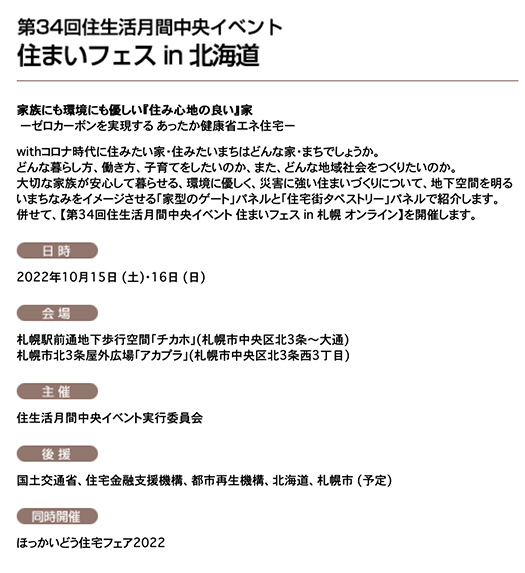

さてきのうは北海道の住宅施策の諮問会議に参加しておりました。
いまのところキャッチフレーズ的な名称はまだ決まっていませんが、
「北方型住宅ZEH/ゼロカーボンモデル」という概念で住宅仕様を考えている。
北海道は明治開拓期以来、日本にとって新開拓地域として
多くの日本人が定住することが国家的命題として追究された。
現代でもその基本構図が変わらないロシアの南下領土欲求に対して
もっとも確実で有効性の高い「国防」施策として
多数の日本人の移住促進、定住の安定化が目指された。
北海道開拓使という時限的「中央省庁」が設立され
のちに総理大臣にも就任した黒田清隆らが心血を注いだ。
明治初年の箱館戦争で国を統一させてすぐに引き続いて、
樺太での対ロ交渉によって北海道の日本領土を確定させて以降、
黒田清隆は世界中を巡り歩いて、寒冷気候に対応できる日本人の家を
研究し続けた。自ら屋根に上がって工事までしていた逸話が残っている。
外交交渉でなんとか北海道の日本帰属を確定させたけれど、
本当の国防的勝利とは北海道に多数の日本人が移り住むことだった。
ロシアの住宅などにも樺太で接し一時期はログハウスにも強い興味を持ち
実際に実験的に建築させたりしていた。
しかし最終的にはアメリカ北東部の住宅仕様を基本にして
アメリカ人住宅技術者たちを「お雇い外国人」として採用し、
札幌などの都市建設に当たらせた。
できあがった札幌の市街景観は目指すべき「坂の上の雲」を日本人に見せた。
明治以降の日本国家の基調、欧米キャッチアップにおいて
北海道はその巨大な実験室、文明受容・先進性文化の展示場だったのだろう。
明治帝は開拓使の仕上げとして行幸されたが、
船で上陸した小樽から当時の最先端文明装置・鉄道で札幌まで移動された。
明治帝が象徴の日本総体は北海道を欧米移植実験地として見る文化が根付いた。
しかし北米に於いても、この時代相のなかでは断熱気密という
根源的住宅要素技術は木造工法段階でとどまっており、基本の大工技術は
日本の開放建築工法であって寒冷地住宅として合目的的とは言えなかった。
中央省庁・北海道開拓使の時代が終わったあと、
寒冷地住宅の工法革命は戦後になってようやく実質が始められた。
日本建築に「寒冷地であたたかい家はどう作るの?」と問いかけ続けたが
無い袖は振れないという対応だったのだ。
結局北海道は、北欧北米との情報共有によって技術基盤を確立できた。
黒田清隆の奮闘の正しさは100年程度の時間経過の後、ようやく浸透した。
ことし国の住生活月間の中央イベント会場は札幌開催。
同時開催で北海道も最新の住宅イベントを予定している。
いま現在の北海道の住宅文化の羅針盤を示すことにもなる。
ふつうの北海道人の家づくり意識を主役に据えた制度設計を目指したい。
English version⬇
2022 Housing Month Central Event + Hokkaido-Housing Fair
A desire for high-performance housing for the entire region since the Meiji pioneering period. The contemporary compass design of Hokkaido housing, always keeping an eye on future forms. The design of the modern compass of Hokkaido housing, which has always been looking to the future form.
Yesterday, I attended a meeting of the Hokkaido Housing Policy Advisory Council.
At the moment, we have not yet decided on a catchphrase-like name for the project.
We are considering housing specifications based on the concept of “Northern Style Housing ZEH/Zero Carbon Model.
Hokkaido has been a new frontier region for Japan since the Meiji era (1868-1912).
Hokkaido was pursued as a national proposition for the settlement of many Japanese people as a new frontier region for Japan since the Meiji era.
Even today, the basic structure of this concept remains the same, and it is the most reliable and effective way to respond to Russia’s desire for territory to the south.
As the most reliable and effective “national defense” measure
The goal was to promote the emigration of large numbers of Japanese and to stabilize the settlement of Japanese.
A temporary “central ministry” called the Hokkaido Kaitakushi (Hokkaido Development Office) was established.
Kiyotaka Kuroda, who later became prime minister, and others devoted themselves to the project.
The Hakodate War of the first year of the Meiji era united the country, and soon after, negotiations with
After establishing Japanese territory in Hokkaido through negotiations with Russia in Sakhalin, Kuroda Kiyotaka traveled around the world.
Kiyotaka Kuroda traveled around the world to find a Japanese house that could cope with the cold climate.
He even climbed up on the roof and built it himself. There is an anecdote that he even went up on the roof himself to do construction work.
Although he managed to secure Japan’s claim to Hokkaido through diplomatic negotiations, it was not a real victory in terms of national defense.
The real victory in terms of national defense was the relocation of a large number of Japanese people to Hokkaido.
In Sakhalin, he came into contact with Russian housing and for a time had a strong interest in log cabins, and actually had log cabins built on an experimental basis.
He was even allowed to experiment with log houses.
In the end, however, he decided to build a log house based on the specifications of houses in the northeastern United States.
He hired American housing engineers as “hired foreigners,” and
They were hired as “hired foreigners” to build cities such as Sapporo.
The resulting cityscape of Sapporo showed the Japanese the world of “clouds over the hill” that they should aspire to.
Hokkaido was a huge laboratory for the Japanese nation’s post-Meiji efforts to catch up with Europe and the United States.
Hokkaido was a huge laboratory, an exhibition hall for the acceptance of civilization and advanced culture.
The Meiji Emperor went to Hokkaido as the finishing touch of his mission to develop the island.
He traveled from Otaru, where he landed by ship, to Sapporo by rail, the most advanced civilization equipment of the time.
The Japanese culture, as symbolized by the Meiji Emperor, had taken root in Hokkaido as a test site for Western transplants.
However, even in North America, the fundamental housing element technology of heat insulation and airtightness was not developed in this period.
The basic housing element technology of heat insulation and airtightness remained at the wooden construction stage, and the basic carpentry techniques were based on the open construction methods of Japanese building technology.
The basic carpentry techniques were not suitable for cold-weather housing, as they were based on open construction methods of Japanese building techniques.
After the era of the central government and the Hokkaido Settlement Administration ended, a revolution in cold-weather housing construction methods began to take place.
The revolution in cold-weather housing finally began to take shape in the postwar period.
The existing Japanese architecture kept asking the question, “How do you make a warm house in a cold region? but the response was that it was impossible to make a warm house in a cold climate.
The response was that they could not give up what they did not have.
In the end, Hokkaido was able to establish a technical foundation by sharing information with Northern Europe and North America.
The correctness of Kiyotaka Kuroda’s efforts finally became widespread after a lapse of about 100 years.
The central event venue for the country’s Housing and Living Month this year was Sapporo.
Hokkaido also plans to hold its latest housing event at the same time.
The event will also serve as a compass for Hokkaido’s current housing culture.
We would like to design a system that places the home-building consciousness of ordinary Hokkaido residents at the center of the event.
Posted on 7月 29th, 2022 by 三木 奎吾
Filed under: 住宅マーケティング, 住宅性能・設備







コメントを投稿
「※誹謗中傷や、悪意のある書き込み、営利目的などのコメントを防ぐために、投稿された全てのコメントは一時的に保留されますのでご了承ください。」
You must be logged in to post a comment.